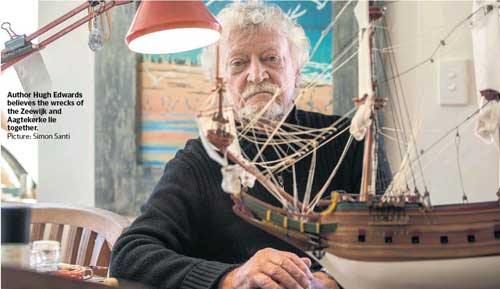
'Aagtekerke' - lost 1726
The 280-tonne, 44-metre long Aagtekerke, constructed in 1724 for the Dutch East India Company (VOC) was the identical sister ship of the Zeewijk. Commanded by Jan Witboon, and with a crew of 200 men, the Aagtekerke left Cape Town for Batavia (Jakarta, Indonesia) on 3 January 1726, never to be seen or heard of again. Did it, too, suffer the same fate as the Batavia and Zeewijk?
It is thought by many and hoped by treasure hunters, that its route may have lead it to be wrecked on the Western Australian coast. There is some evidence from the crew of the wrecked ship Zeewyk that Aagtekerke may have also been wrecked on the Abrolhos Islands a year earlier.
When The Zeewijk was wrecked, the crew saw, on the same reef that they struck, such things as old rope, rawhide and a hand-grenade, things that could only be debris from another ship. Many historians believe that these items might well br from The Aagtekerke which vanished in 1726, about a year and a half before the Zeewijk was wrecked. Identical in their design and armaments, The Zeewijk and The Aagtekerke were twin sister ships.
In 1963, Western Australian shipwreck hunter Hugh Edwards and a team of divers, found the wreck of the Zeewijk. Later in 1966, while spearfishing only 300m away from the wreck, Hugh found an elephant tusk, which he believed indicated that there was another wreck, and that it probsbly was the Aagtekerke. The Aagtekerke took on 214 ivory tusks at the Cape but the Zeewijk had none.

Hugh Edwards at the sheet anchor of what he believes might be the Aagtekerke
Do the wrecks of the Aagtekerke and Zeewyjk lie together?
Could it possibly be that two eerily similar 18th century ships, built a year apart in the Netherlands for the same company, by the same shipwright, in the same shipyard, could end up wrecked together at the same place on the other side of the world? Hugh Edwards says that is exactly what happened. Over nearly 50 years he has pieced together a compelling case to back up his theory that the wrecks of the Zeewijk, which he discovered in 1968, and the Aagtekerke, lie together on a treacherous reef in the Abrolhos Islands, off the Mid West coast of WA.Hugh and his colleagues had already concluded there were too many cannons and anchors for one ship, and that there had to be two. They found 44 guns at the Zeewijk wreck site, more than the usual number of 36 on such a ship. Nine anchors were also found but the Zeewijk would not have had no more than six. That there are two concentrations of wreckage on Half-Moon Reef (both outside the reef but 2-300m apart), adds further weight to Edwards' suspicions. As amazing as it might sound, the evidence points to the wreck of the Aagtekerke being within 300m of her twin sister the Zeewijk.
The coin from the Zeewijk's was all salvaged by the crew, recorded and returned to the owner, the Dutch East India Company, but the Aagtekerke's treasure wasn't. If the coins are ever found, then there will be little doubt that the wreck is that of The Aagtekerke. However, finding about 30,000 silver coins that will have been scattered by waves and currents on ragged reefs over hundreds of years, would be both difficult and dangerous.
As you can imagine, the theory of one shipwreck almost on top of the other has many critics skeptical. Putting the contrary view has been Jeremy Green, Head of the Maritime Archaeology Department of Western Australian Museum. He has suggested that there is no excess of cannon and anchors, that the ivory tusks which have been found could have been private cargo carried by the Zeewijk, and that the wreckage the Zeewijk survivors observed was from another wrecksite in the Abrolhos Islands, and not from another wreck at the Zeewijk site.
As for part of the evidence of previous human presence, a well, Green suggests it may have been dug by the boat crew from the Vergulde Draeck, on their way to Batavia (Jakarta) in May 1656 to raise the alarm.
One highly contentious element has been the reference in the journal of Second Mate Adriaen van der Graeff to material indicating prior human presence. The debate centres on which transcription of the journal is the most valid source, and the translation of reference to a 'honds geraemte' ('dog's skeleton') or 'gevolde handgranaad' ('filled hand-grenade').
The Maritime Archaeology Department does acknowledge that there is possibly another wreck in the Southern Group of the Abrolhos. So the cat is out of the bag so to speak, and if any new evidence does turn up, it will certainly create a sensation.
Footnote: Under the Historic Shipwrecks Act of 1976, wrecks, relics and treasure, belong to the Federal Government.

Veteran Wa shipwreck hunter, Hugh Edwards